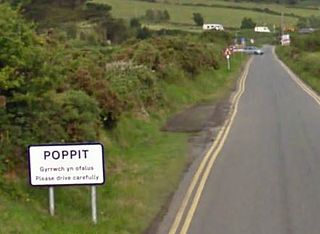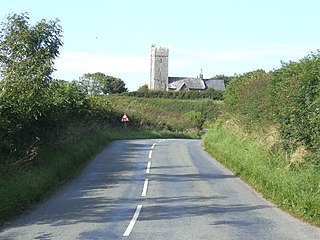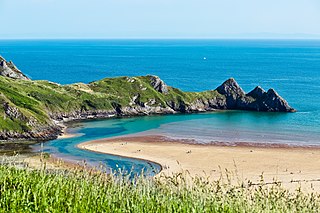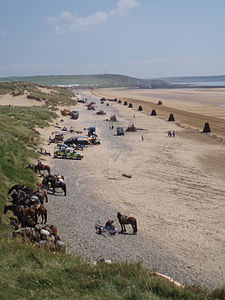
The Pembrokeshire Coast Path, often called the Pembrokeshire Coastal Path, is a designated National Trail in Pembrokeshire, southwest Wales. Established in 1970, it is a 186-mile (299 km) long-distance walking route, mostly at cliff-top level, with a total of 35,000 feet (11,000 m) of ascent and descent. At its highest point – Pen yr afr, on Cemaes Head – it reaches a height of 574 feet (175 m), and at its lowest point – Sandy Haven crossing, near Milford Haven – it is just 6 feet (2 m) above low water. Whilst most of the coastline faces west, it offers – at varying points – coastal views in every direction of the compass.

Pembrokeshire is a county in the south-west of Wales. It is bordered by Carmarthenshire to the east, Ceredigion to the northeast, and is otherwise surrounded by the sea. Haverfordwest is the largest town and administrative headquarters of Pembrokeshire County Council.

The Bristol Channel is a major inlet in the island of Great Britain, separating South Wales and South West England. It extends from the smaller Severn Estuary of the River Severn to the North Atlantic Ocean. It takes its name from the English city and port of Bristol.

Pembrokeshire Coast National Park is a national park along the Pembrokeshire coast in west Wales.

St Brides Bay is a bay in western Pembrokeshire, West Wales.

Abereiddy is a hamlet in the county of Pembrokeshire, in west Wales.

The Stackpole Estate is located between the villages of Stackpole and Bosherston in Pembrokeshire, Wales, within the Pembrokeshire Coast National Park. It is situated within the community of Stackpole and Castlemartin.

Poppit is a small, dispersed settlement which lies on the southern side of the estuary of the River Teifi, near Cardigan, in northern Pembrokeshire, Wales.

Barafundle Bay is a remote, slightly curved, east-facing sandy beach, near Stackpole Quay in Pembrokeshire, Wales. It is part of the Stackpole Estate, managed by The National Trust. The beach was once owned by the Cawdor family of Stackpole Court. On the northern approach to the beach are steps and a wall, which were built by the owners to ease their access to what was then their private beach.

Bosherston is a village and parish in Pembrokeshire, Wales, within the Pembrokeshire Coast National Park.

Freshwater East is a village in Pembrokeshire, Wales. The majority of the village is on a cliff overlooking a bay. It is approximately 7 miles (11 km) from Pembroke by road, and 2 miles (3.2 km) south of Lamphey, and is in the parish and community of Lamphey. Freshwater East is the site of a Green Coast Award Beach.
Castlemartin is a village and parish in the community of Stackpole and Castlemartin, Pembrokeshire, Wales, in the Pembrokeshire Coast National Park.

Castlemartin Training Area is a British Army military training area and armoured fighting vehicle range located in the Welsh county of Pembrokeshire. It was originally established for tank training by the Royal Armoured Corps in 1938. The training area is located within the Pembrokeshire Coast National Park, on the South Pembrokeshire coast.

h The B4319 is a road in Pembrokeshire in Wales. It starts from the A4139 at 51°40′23″N4°54′43″W in Pembroke, to continue towards the Stackpole Estate. It heads for Castlemartin, passes Freshwater West and terminates at its junction with the B4320 at 51°40′4″N5°3′41″W near Angle.

Pwllgwaelod is a small scattered hamlet centred on a bay on the south-western side of the Dinas Island peninsula. It is in the community of Dinas Cross between Fishguard and Newport, Pembrokeshire, Wales. Many of the properties within the hamlet of Pwllgwaelod are holiday cottages.

St Govan's Chapel is a chapel located at St Govan's Head, Pembrokeshire in south west Wales.

Fishguard and Goodwick is the name of a community that wraps around Fishguard Bay, on the northern coast of Pembrokeshire, Wales. It comprises the two towns of Fishguard and Goodwick, with their neighbourhoods of Dyffryn, Harbour Village, Penyraber, Lower Town, and Stop-and-Call. Within the community are two railway stations and Goodwick Ferry Terminal, which is the terminus of the A40 London to Fishguard Trunk Road.

The coastline of Wales extends from the English border at Chepstow westwards to Pembrokeshire then north to Anglesey and back eastwards to the English border once again near Flint. Its character is determined by multiple factors, including the local geology and geological processes active during and subsequent to the last ice age, its relative exposure to or shelter from waves, tidal variation and the history of human settlement and development which varies considerably from one place to another. The majority of the coast east of Cardiff in the south, and of Llandudno in the north, is flat whilst that to the west is more typically backed by cliffs. The cliffs are a mix of sandstones, shales and limestones, the erosion of which provides material for beach deposits. Of the twenty-two principal areas which deliver local government in Wales, sixteen have a coastline, though that of Powys consists only of a short section of tidal river some distance from the open sea. Its length has been estimated at 1,680 miles (2,700 km).
The geology of Pembrokeshire in Wales inevitably includes the geology of the Pembrokeshire Coast National Park which extends around the larger part of the county's coastline and where the majority of rock outcrops are to be seen. Pembrokeshire's bedrock geology is largely formed from a sequence of sedimentary and igneous rocks originating during the late Precambrian and the Palaeozoic era, namely the Ediacaran, Cambrian, Ordovician, Silurian, Devonian and Carboniferous periods, i.e. between 635 and 299 Ma. The older rocks in the north of the county display patterns of faulting and folding associated with the Caledonian Orogeny. On the other hand, the late Palaeozoic rocks to the south owe their fold patterns and deformation to the later Variscan Orogeny.
























